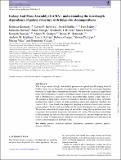Galaxy And Mass Assembly (GAMA) : understanding the wavelength dependence of galaxy structure with bulge-disc decompositions
Abstract
With a large sample of bright, low-redshift galaxies with optical-near-IR imaging from the GAMA survey we use bulge-disc decompositions to understand the wavelength-dependent behaviour of single-Sérsic structural measurements. We denote the variation in single-Sérsic index with wavelength as N, likewise for effective radius we use R. We find that most galaxies with a substantial disc, even those with no discernable bulge, display a high value of N. The increase in Sérsic index to longer wavelengths is therefore intrinsic to discs, apparently resulting from radial variations in stellar population and/or dust reddening. Similarly, low values of R (<1) are found to be ubiquitous, implying an element of universality in galaxy colour gradients. We also study how bulge and disc colour distributions vary with galaxy type. We find that, rather than all bulges being red and all discs being blue in absolute terms, both components become redder for galaxies with redder total colours. We even observe that bulges in bluer galaxies are typically bluer than discs in red galaxies, and that bulges and discs are closer in colour for fainter galaxies. Trends in total colour are therefore not solely due to the colour or flux dominance of the bulge or disc.
Citation
Kennedy , R , Bamford , S P , Häußler , B , Baldry , I , Bremer , M , Brough , S , Brown , M J I , Driver , S , Duncan , K , Graham , A W , Holwerda , B W , Hopkins , A M , Kelvin , L S , Lange , R , Phillipps , S , Vika , M & Vulcani , B 2016 , ' Galaxy And Mass Assembly (GAMA) : understanding the wavelength dependence of galaxy structure with bulge-disc decompositions ' , Monthly Notices of the Royal Astronomical Society , vol. 460 , no. 4 , pp. 3458-3471 . https://doi.org/10.1093/mnras/stw1176
Publication
Monthly Notices of the Royal Astronomical Society
Status
Peer reviewed
ISSN
0035-8711Type
Journal article
Description
This paper is based on work made possible by NPRP award 08-643-1-112 from the Qatar National Research Fund (a member of The Qatar Foundation). GAMA is funded by the STFC (UK), the ARC (Australia), the AAO, and participating institutions. RK acknowledges support from the Science and Technology Facilities Council (STFC). SPB gratefully acknowledges the receipt of an STFC Advanced Fellowship. BV acknowledges the financial support from the World Premier International Research Center Initiative (WPI), MEXT, Japan and the Kakenhi Grant-in-Aid for Young Scientists (B)(26870140) from the Japan Society for the Promotion of Science (JSPS) SB acknowledges the funding support from the Australian Research Council through a Future Fellowship (FT140101166).Collections
Items in the St Andrews Research Repository are protected by copyright, with all rights reserved, unless otherwise indicated.
Related items
Showing items related by title, author, creator and subject.
-
SDSS-IV MaNGA: How the stellar populations of passive central galaxies depend on stellar and halo mass
Oyarzún, Grecco A.; Bundy, Kevin; Westfall, Kyle B.; Tinker, Jeremy L.; Belfiore, Francesco; Argudo-Fernández, Maria; Zheng, Zheng; Conroy, Charlie; Masters, Karen L.; Wake, David; Law, David R.; McDermid, Richard M.; Aragón-Salamanca, Alfonso; Parikh, Taniya; Yan, Renbin; Bershady, Matthew; Sánchez, Sebastián F.; Andrews, Brett H.; Fernández-Trincado, José G.; Lane, Richard R.; Bizyaev, D.; Boardman, Nicholas Fraser; Lacerna, Ivan; Brownstein, J. R.; Drory, Niv; Zhang, Kai (2022-07-06) - Journal articleWe analyze spatially resolved and co-added SDSS-IV MaNGA spectra with signal-to-noise ratio ∼100 from 2200 passive central galaxies (z ∼ 0.05) to understand how central galaxy assembly depends on stellar mass (M*) and halo ... -
Secular-and merger-built bulges in barred galaxies
Mendez Abreu, Jairo; Debattista, V. P.; Corsini, E. M.; Aguerri, J. A. L. (2014-12) - Journal articleContext. Historically, galaxy bulges were thought to be single-component objects at the center of galaxies. However, this picture is now questioned since different bulge types with different formation paths, namely classical ... -
Galaxy And Mass Assembly (GAMA) : galaxy close pairs, mergers and the future fate of stellar mass
Robotham, A. S. G.; Driver, S. P.; Davies, L. J. M.; Hopkins, A. M.; Baldry, I. K.; Agius, N. K.; Bauer, A. E.; Bland-Hawthorn, J.; Brough, S.; Brown, M. J. I.; Cluver, M.; De Propris, R.; Drinkwater, M. J.; Holwerda, B. W.; Kelvin, L. S.; Lara-Lopez, M. A.; Liske, J.; Lopez-Sanchez, A. R.; Loveday, J.; Mahajan, S.; McNaught-Roberts, T.; Moffett, A.; Norberg, P.; Obreschkow, D.; Owers, M. S.; Penny, S. J.; Pimbblet, K.; Prescott, M.; Taylor, E. N.; van Kampen, E.; Wilkins, S. M. (2014-11-11) - Journal articleWe use a highly complete subset of the Galaxy And Mass Assembly II (GAMA-II) redshift sample to fully describe the stellar mass dependence of close pairs and mergers between 10(8) and 10(12)M(circle dot). Using the analytic ...

